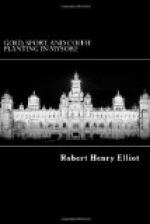In the case of well cultivated estates, an expenditure of eighty rupees per acre is incurred on superintendence and field labour, and fifty rupees an acre on manures and their application, but in many European, and most native estates, a total expenditure for superintendence, labour and manures of about eighty rupees only is incurred, and the results obtained are, of course, proportionately smaller. The native gardens and plantations are, as a rule, worked on the principle of taking everything that can be got out of the land, and putting nothing into it. Were these worked on European principles, it is hardly necessary to say that the export of coffee from Coorg would be largely increased.
Cattle manure, bones, oil-cake and fish constitute the manures mainly used in Coorg. The first is universally recognized as being the most valuable for coffee, but the supply available in the Bamboo district (which contains, I may remind the reader, 20,000 out of the 32,323 acres under cultivation by Europeans), where grazing is scarce, is so small that planters have to depend to a great extent on the three last-named manures. Messrs. Matheson & Co., the owners of about 7,000 acres of coffee in Coorg, kept for some years in their employ an analytical chemist,[49] whose time was devoted to the analysis of soil, and the making of experiments on their estates, with the view of ascertaining what was best adapted for maintaining and improving their fertility. Salts of various kinds were experimented with, but, though the results from them were generally favourable, they were found to be too rapidly soluble for a climate so subject to heavy falls of rain. In the end, after many experiments, he came to the conclusion that the four above-mentioned manures were the best for the climate, and that the proportion applied should vary with the condition of the coffee. To illustrate this point I may add that in Coorg, bones and oil-cake are usually applied in the proportion of two of the latter to one of the former. If, however, a field has suffered badly from leaf disease (which destroys many of the leaves), or is not making wood as rapidly as it ought, it is customary to apply a larger proportion of oil-cake, or in some cases, to put down that manure without adding any bones. On the other hand, if there is a superabundance of wood, and it is desirable to throw the whole energies of the tree into the production of berries, then the proportion of bone manure is increased and that of oil-cake diminished.
In former times all manures were applied immediately after the crop was picked, and on estates where labour is scarce, or comes in late in the season, this system is still carried on. But from results actually obtained on estates in Coorg, it has now been proved that it is more advantageous to apply part of the manure immediately after crop, in order to strengthen the tree when the blossom showers fall (which they usually do in March and April), and to aid it in perfecting




